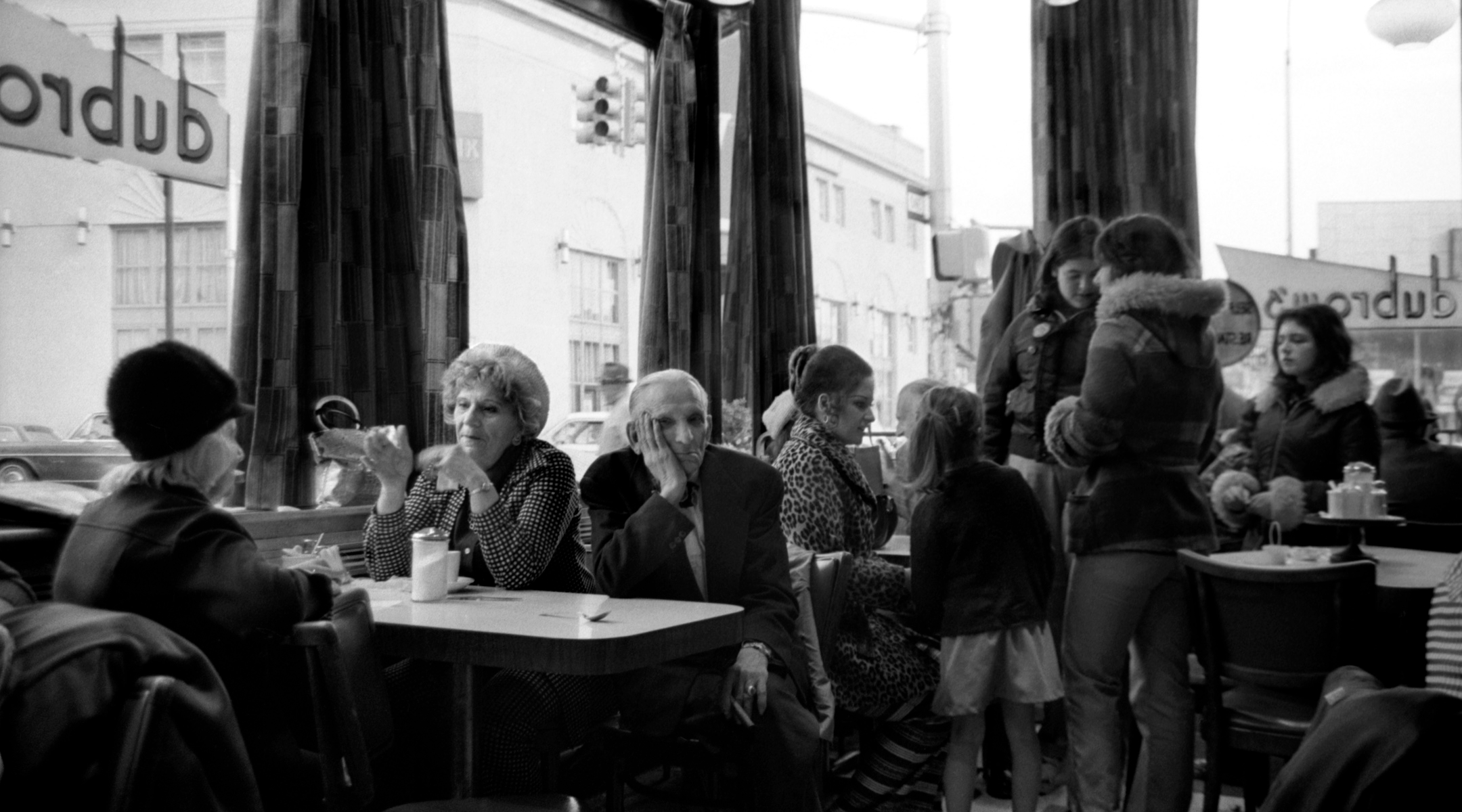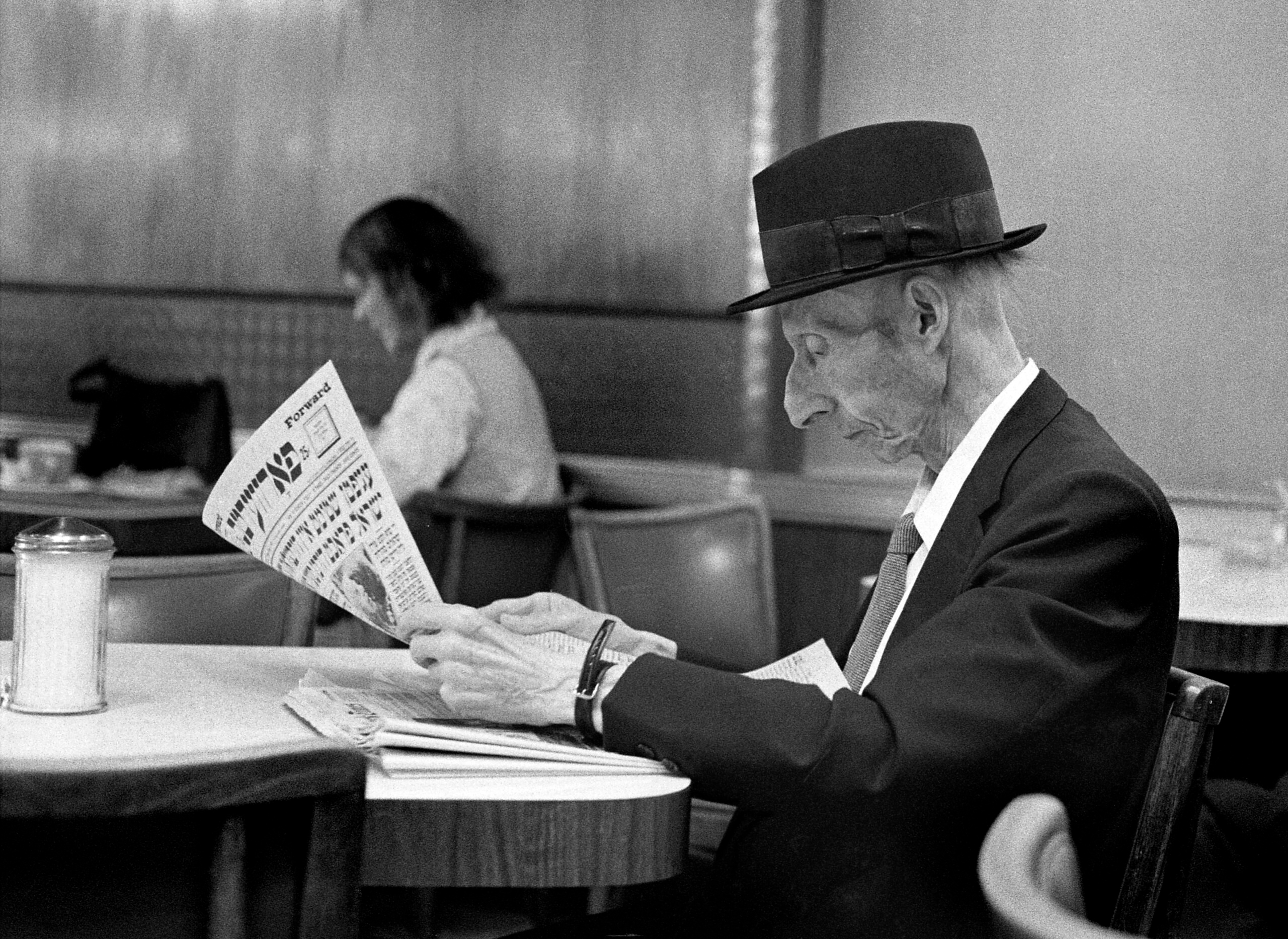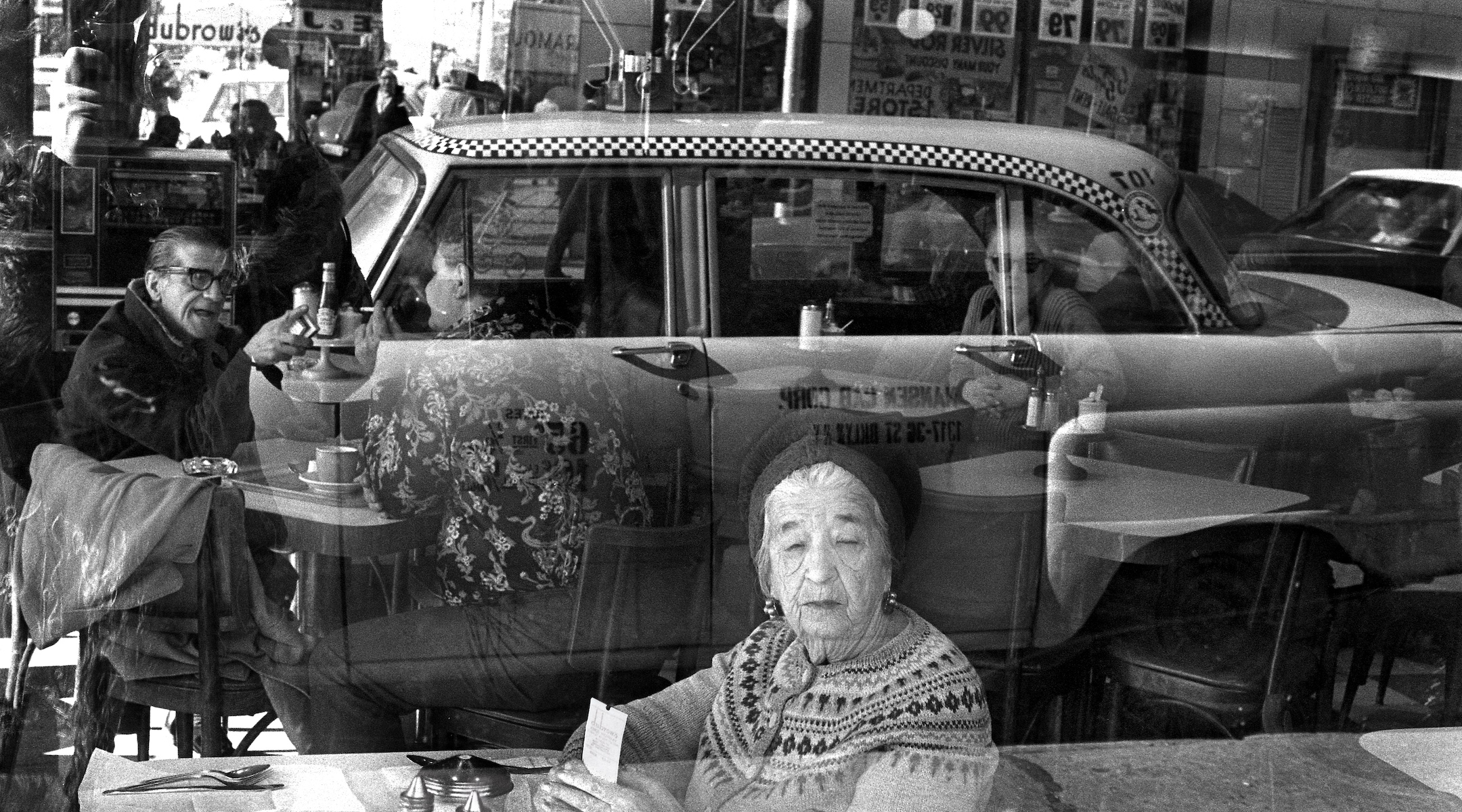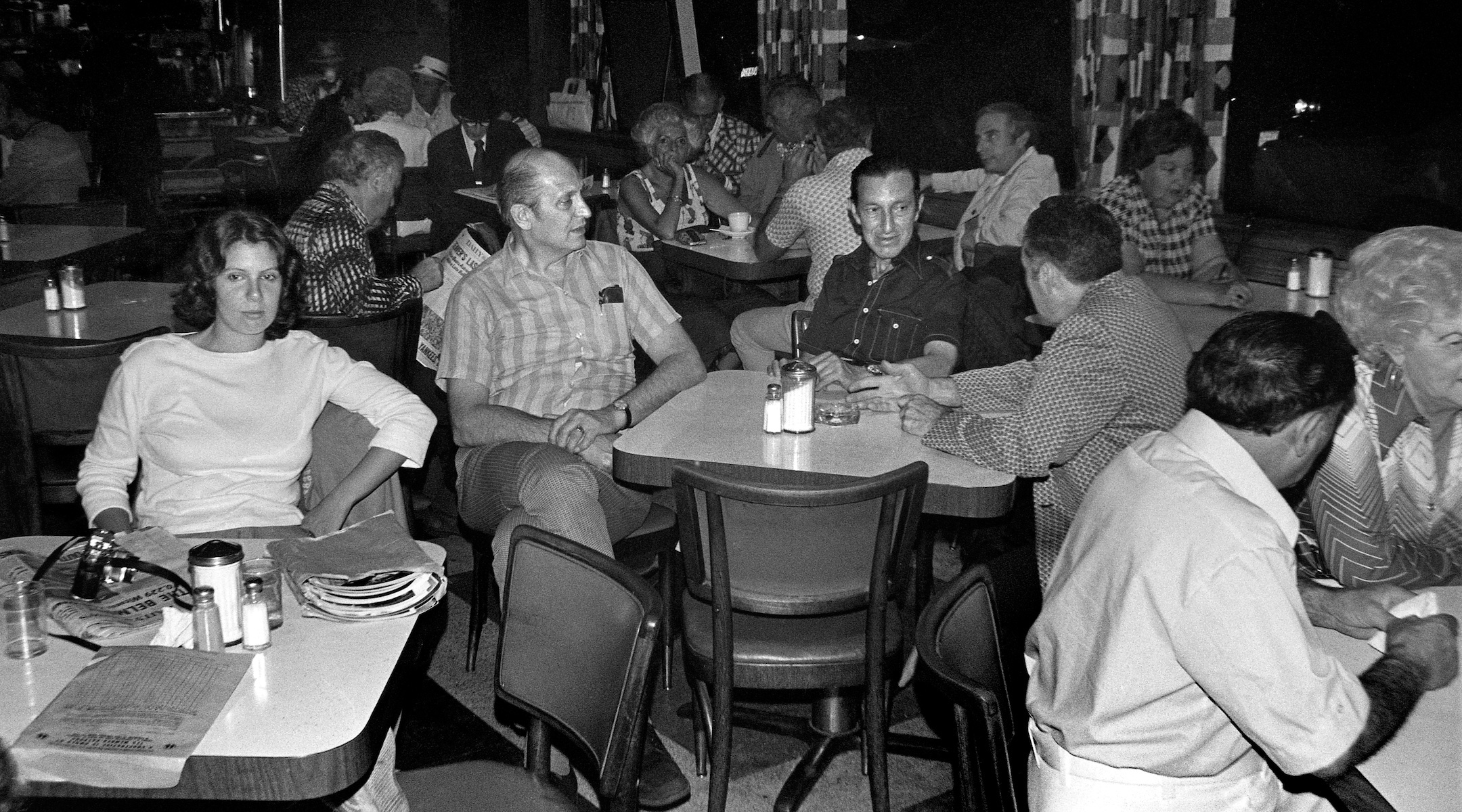A new photo book celebrates the very Jewish cafeteria culture of a vanished New York
(New York Jewish Week) – Again in 1975, Marcia Bricker Halperin had simply graduated from Brooklyn Faculty with the dream of changing into an expert photographer when she stepped into the Flatbush outpost of Dubrow’s, a cafeteria-style restaurant, for a heat cup of espresso.
It was there that inspiration hit. “I used to be wonderstruck,” Halperin writes within the introduction to her new ebook of pictures, “Kibbitz & Nosh: When We All Met at Dubrow’s Cafeteria,” describing the “cavernous” area with mirrored partitions and a mosaic fountain. “It was essentially the most idiosyncratic room I had ever seen.”
“I sensed it was a vanishing world on its final legs, and that impelled me to doc it,” she continues. “On many visits, the tables had been empty, sans a painterly nonetheless lifetime of condiment bottles and jars within the morning gentle. I additionally perceived cafeterias as locations that embodied a secular Jewish tradition, one thing that was of nice curiosity to me.”

“I attended a lecture by Isaac Bashevis Singer, who was billed as an “Excellent Anglo -Yiddish” creator, on the Brooklyn Jewish Heart on Jap Parkway in Crown Heights,” Bricker Halperin writes within the introduction. “I adored his quick tales, lots of which had been set in cafeterias, and I remorse by no means discovering the nerve that day to inform him about my very own cafeterianiks.” (Marcia Bricker Halperin)
Halperin was prescient: She began photographing these once-ubiquitous eateries one decade earlier than the ultimate Dubrow’s location within the Garment District would shut in 1985. The chain’s first location was based in 1929 on the Decrease East Facet by Benjamin Dubrow, a Jewish immigrant from Minsk. By the mid-twentieth century, the family-owned firm expanded all through Brooklyn, Manhattan and Miami Seaside, with possession passing to the second technology, after which to the third. In Dubrow’s prime, a cease at one of many cafeterias was virtually required for politicians corresponding to John F. Kennedy and Jimmy Carter.
Almost 50 years after her first go to, Halperin’s new ebook is a tribute to this now-defunct New York Metropolis cafeteria tradition and the characters she met through the 5 years she often photographed there. The compelling 152-page ebook options her unique black-and-white pictures together with essays from Pulitzer Prize–successful playwright Donald Margulies and Jewish American historian Deborah Sprint Moore.
“Though Jews weren’t the one ones to patronize cafeterias, they most well-liked them as cheap locations to hang around to bars, which regularly attracted an Irish immigrant or working-class clientele,” Moore writes in her essay, titled “See You at Dubrow’s.” “By the Nineteen Thirties, cafeterias had been a part of the material of Jewish neighborhood life in New York Metropolis, a welcome different for socializing to cramped residences, road corners, or sweet shops.”
Now dwelling in Park Slope and retired from a profession as a particular training instructor, Halperin talked with the New York Jewish Week concerning the metropolis’s misplaced cafeteria tradition and what impressed her to seize it together with her digital camera.
This interview has been edited for size and readability.
New York Jewish Week: You took these pictures almost 50 years in the past. What made you resolve to publish them now?
Marcia Bricker Halperin: Within the Seventies, there was such good suggestions on the work. I used to be given a present, I used to be collected by a couple of folks, I had a photograph in The New York Occasions. Folks wrote me letters within the mail: “Ms. Bricker, I’m taken with shopping for considered one of your pictures.” On the time, I used to be in a mission referred to as the CETA artists mission, a federally funded arts mission within the ’70s the place I used to be paid to be a photographer. It was very very similar to the [Depression-era] WPA mission, however one of many nice variations with the CETA mission was something you shot, you owned.
So I continued photographing altering New York throughout these years — a few of it by project for nonprofit organizations that I labored with, just like the Jewish Museum and a company in Brighton Seaside that was resettling the Soviet Jews that had been arriving within the ’70s. They needed pictures to assist each the Soviet Jews perceive American life and the outdated Jewish inhabitants in Brighton Seaside perceive Russian life. What a fantastic alternative!
I used to be going to be an artist and I did adjunct instructing and various things to make it work. I form of fell into instructing highschool pictures after which, from there, I fell into instructing particular training — that took over. Thirty-five years later, I retired from instructing. The day after I retired, I took out my negatives and my pictures stuff and acquired a scanner and all types of printers and issues.
So, I used to be a photographer as soon as upon a time after which taught for a few years and, in a single day, I turned one as soon as once more.
Assist the New York Jewish Week
Our nonprofit newsroom is dependent upon readers such as you. Make a donation now to help unbiased Jewish journalism in New York.

A person reads the Forvertz newspaper in Yiddish. (Marcia Bricker Halperin)
How did it really feel to see these pictures once more? Had you developed any of them earlier than?
Sure, I printed fairly a couple of of them then. I labored as a darkroom lab technician, so I had a possibility within the ’70s to do a variety of silver gelatin prints. I might usher in a thick envelope of the imperfect prints to the cafeteria and at that time, all people knew me. I gave out portraits to folks. If I hadn’t shot them, they’d collect round me asking: “Do you have got my image? Did you print it?” Particularly the workers — there was a really worldwide cohort of individuals working there they usually all needed photos to ship dwelling to their households.
After that, the photographs lay fallow for all these years. I protected them and saved them very rigorously. After I had the chance to return again and put collectively a pattern ebook, I began trying by means of the negatives and I stated, “Oh, my God, I don’t keep in mind that image.” It was a time warp to see a few of these pictures taken within the Seventies. In Manhattan, the ’60s had occurred, however Flatbush in Brooklyn was the “Previous Nation.” It hung onto the previous for some time and a few ladies dressed like they had been nonetheless within the Nineteen Fifties.

Dubrow’s Cafeteria, Kings’s Freeway 1975. The photographer seems within the prime left nook. (Marcia Bricker Halperin)
Dubrow’s closed simply ten years after you began capturing there. Might you’re feeling on the time that cafeteria tradition was ending?
I saved a journal on the time. After I went again 42 years later to have a look at it, I had written: “Sooner or later I’m going to indicate up right here and that is going to be closed.”
There have been different cafeterias in Manhattan and the Bronx they usually had all closed. I’ve collected like each article ever written about cafeterias, and there’s one from 1973: “Are cafeterias going to be gone?” So it was pretty well-known that this was a vanishing form of institution in New York. The automats ceased having the little bins, Burger King purchased them out, they tried to modernize and it bought fairly unhappy. Generally through the day, the large cafeteria can be empty and folks would say, “This enterprise can’t survive.” So I knew I used to be photographing within the vein of needing to doc the issues which might be there and will probably be gone. It was one of many issues that propelled me to get on the market and {photograph}.
At the moment, issues are completely different. There’s meals courts and fantastic little espresso locations. There are a lot of companies, particularly right here in Brooklyn, making an attempt to perpetuate “grandmother meals” and there are eating places which might be serving “reinvented Jewish-style meals.” So there are some continuations, however by way of the large, opulent cafeteria areas — grand skilled murals, intricate woodworking, meals with a loopy quantity of preparation, 300 objects, 30 completely different desserts — no restaurant might presumably survive like that. The one factor that also exists are my pictures of them.

Women and men converse round empty tables at Dubrow’s on Kings Freeway. (Marcia Bricker Halperin)
What was the Jewish tradition of Dubrow’s and Flatbush like on the time?
Rising up, we went to just a little outdated “Conservadox” synagogue. We had been the form of household the place my mom saved a kosher kitchen at dwelling, however on Sunday nights we’d exit to the Chinese language restaurant. Dubrow’s menu was “Jewish-style” nevertheless it was additionally a spot you might exit and have your first shrimp salad sandwich, which turned their hottest meals. They had been well-known for shrimp salad!
These cafeterias had been all began by Jewish immigrants. However they had been democratic for everybody — there was ham on the menu, shrimp. You can select whether or not to have simply meat or have a meat meal after which have a cream pie for dessert. That was your selection. With cafeteria-style, like faith, you decide and select what you need and what you need to observe.
After I would go there, all of the older folks would ask: “Are you Jewish? You don’t look Jewish.” I’d say,“I’m Jewish. I do know a couple of phrases of Yiddish, my dad and mom converse Yiddish at dwelling.” They might be happy with that. There was this sense that it was a membership just a little bit, it was a Jewish institution. Not that everyone wasn’t welcome, and all people socialized with everybody else.
Socializing was a giant factor there, not essentially consuming. A lot of my photos are folks sitting round — generally it’s a espresso cup on the desk, more often than not the desk is empty. They had been there to satisfy their associates and speak. Some folks stated it changed the synagogues. The outdated males would go to Dubrow’s and have a cup of espresso with their associates within the morning and gossip and speak.
Assist the New York Jewish Week
Our nonprofit newsroom is dependent upon readers such as you. Make a donation now to help unbiased Jewish journalism in New York.
“Kibbitz & Nosh: When We All Met at Dubrow’s Cafeteria” will probably be printed on Could 15, 2023. The pictures are on exhibit on the Edward Hopper Home in Nyack, New York by means of June 25.